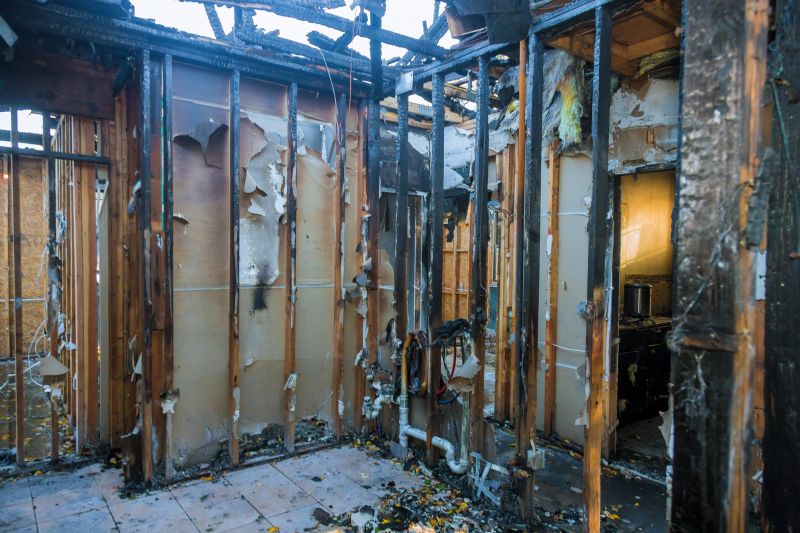Favorite Fire Damage Restoration Products For Home and Business
Explore versatile tools and materials suitable for restoring both residential and commercial fire-affected spaces.
 Fire restoration is a critical process that involves the careful removal of soot, smoke residue, and damaged materials from affected areas. Effective restoration begins with selecting the right products designed to address the unique challenges posed by fire damage. These products are formulated to neutralize odors, clean surfaces, and restore the integrity of building materials. Whether dealing with minor smoke stains or extensive structural damage, choosing appropriate tools and supplies can significantly impact the efficiency and quality of the restoration process.
Fire restoration is a critical process that involves the careful removal of soot, smoke residue, and damaged materials from affected areas. Effective restoration begins with selecting the right products designed to address the unique challenges posed by fire damage. These products are formulated to neutralize odors, clean surfaces, and restore the integrity of building materials. Whether dealing with minor smoke stains or extensive structural damage, choosing appropriate tools and supplies can significantly impact the efficiency and quality of the restoration process.
Top Overall Option
Multi-Purpose Fire Damage Restoration Kit
A comprehensive kit designed to include a variety of cleaning agents, odor neutralizers, protective gear, and tools suitable for different stages of fire damage restoration. It offers versatility for both professional restorers and DIY efforts, providing essential supplies to address soot removal, surface cleaning, and odor control in a single package.
Types of Products For Fire Restorations
Soot and Smoke Cleaners
Specialized solutions formulated to break down soot and smoke residues on various surfaces, ensuring effective cleaning and reduced odor.
Odor Neutralizers
Products designed to eliminate persistent smoke odors from indoor environments, often using enzymes or chemical neutralizers.
Air Scrubbers and Purifiers
Equipment used to filter out airborne particles, soot, and smoke, improving indoor air quality during and after restoration.
Protective Gear
Respirators, gloves, and coveralls to protect workers from exposure to harmful fumes and particles during cleanup.
Dehumidifiers
Devices used to control moisture levels, preventing mold growth and further damage after fire cleanup.
Surface Cleaners
Gentle yet effective cleaners for cleaning furniture, walls, and ceilings affected by smoke and soot.
Restoration Sealants
Sealants used to encapsulate soot and prevent further off-gassing or odor emission from porous surfaces.
Fire-Resistant Drywall and Insulation
Materials designed to replace or reinforce damaged structural components with fire-resistant options.
Cleaning Brushes and Tools
Specialized brushes, scrubbers, and tools to facilitate thorough cleaning of surfaces affected by fire and smoke.
Electrostatic Sprayers
Equipment used to evenly distribute disinfectants and odor neutralizers across surfaces and air spaces.
Popular Choices
Gels that absorb and neutralize odors in enclosed spaces, often used in confined or hard-to-reach areas.
Powerful cleaning solutions formulated for stubborn soot deposits on various surfaces.
High-efficiency particulate air purifiers that trap fine particles and smoke residues from the air.
Compact units suitable for small to medium restoration projects, providing effective air filtration.
Pre-moistened wipes designed for quick cleanup of soot and smoke residues on surfaces.
Sprays formulated to temporarily mask or neutralize odors during the restoration process.
Heavy-duty dehumidifiers to control moisture and prevent secondary damage after fire incidents.
Protective coatings that help contain soot and prevent further damage or off-gassing.
All-in-one kits containing essential cleaning and odor control products for comprehensive restoration.
Devices that evenly distribute disinfectants to sanitize affected surfaces and air spaces.
In fire restoration, specialized cleaning agents are essential for breaking down stubborn soot and smoke residues that adhere to walls, ceilings, and furnishings. Air scrubbers and odor neutralizers are also vital for improving indoor air quality and eliminating lingering smells. Additionally, protective gear such as respirators and gloves help safeguard workers from harmful particles and chemicals during the cleanup. Properly selecting and using these products ensures a safer, more thorough restoration, helping property owners recover more effectively from fire incidents.
Restoration products vary widely in their applications, from heavy-duty cleaning solutions to delicate surface treatments. It's important to consider the specific materials involved, the extent of damage, and the desired outcome when choosing products. High-quality equipment and supplies can facilitate faster work, reduce the need for rework, and contribute to a more comprehensive restoration. Consulting with professionals or experienced suppliers can provide valuable insights into the most suitable products for particular fire damage scenarios, ensuring a thorough and efficient recovery process.
Key Buying Considerations
- Identify the extent of fire and smoke damage to select appropriate products.
- Consider the types of surfaces affected, such as drywall, wood, or fabric, to choose compatible cleaning agents.
- Look for products with proven effectiveness in odor neutralization and soot removal.
- Evaluate the safety features and protective gear included or required for handling chemicals.
- Assess the size and scope of your project to determine whether professional-grade equipment is necessary.
- Check for compatibility with existing restoration tools and equipment.
- Prioritize products that offer ease of use and clear instructions for application.
- Consider the drying and curing times of cleaning agents and sealants to plan restoration schedules.
- Review product labels for any specific handling or storage requirements.
- Compare the cost and availability of replacement parts or refills for equipment like air scrubbers.
- Ensure products are suitable for indoor use and safe for occupied spaces if needed.
- Look for options that provide comprehensive solutions, reducing the need for multiple separate products.
- Research customer reviews and professional recommendations for insights into product performance.
- Verify that products meet any relevant safety standards or certifications.
- Consider environmental conditions, such as humidity and temperature, that could affect product effectiveness.
